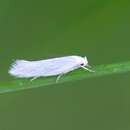Comprehensive Description
provided by Memoirs of the American Entomological Society
Elachista acenteta new species (Figs. 67, 67a, 114.)
Head white, palpi white, narrowly gray on the second segment below. Antennae white, pale gray beneath, and grayish toward tip in male, scape white; slender, the segments longer than broad in both sexes, slightly serrate. Thorax and fore wings pure white above, cilia white; evenly dusted on the underside with pale ashy gray scales. Ground color of hind wings white, in the male evenly and closely dusted with pale ashy gray scales above and below, but paler ■ on the underside, the veins showing as darker lines ; in the female the dusting scarcely contrasting, the wings thus nearly pure white. Cilia white, with a faint yellowish tinge, especially toward their bases. Legs mostly white, fore and midd'e pair somewhat shaded with gray. Abdomen gray above, with posterior margins of segments whitish; whitish beneath.
Alar expanse: 9.5 to 10 mm.
Male genitalia (figs. 67, 67a) : uncus lobes angulate outwardly, a few setae in the angles; gnathos broadly oval; free process of harpe overhanging a deep depression, sacculus processes laterally flattened, broadest before apex, setose ; each lobe of anellus produced laterally into a long prong, setae in two groups ; vinculum rounded, not produced ; aedeagus produced into a blind sac at base, tapering to near the expanded apex; cornutus a branched leaf-like structure, one branch lanceolate, the other heart-shaped.
Female genitalia (fig. 114) : bursa copulatrix lying diagonally in segments 4 and 5, spiculate ; an elongate patch of heavier spicules suggests a signum ; ductus bursae membranous in anterior third, a single coil near junction with the sclerotized and broader posterior two-thirds through which a broad finely dentate stripe runs; the ductus seminalis enters as a sclerotized tube just before the dilated part of the ductus bursae before ostium; the dilation heavily sclerotized at base and sides ; ostium large, situated at the anterior margin of the genital plate.
Type. — S , Parrsboro, Nova Scotia, 29-VI-1944 (J. McDunnough) , [C.N. Coll., Type No. 5734].
Allotype. — 2 , same data as the type, [C. N. Coll., Type No. 5734].
Paratypes. — 2 .5,3$, same data as the types ; 3 S , Ottawa House, Parrsboro, 30-YI-1944 and 5-VII-1944 (J. McDunnough), [C. N.
Coll., No. 5734].
The moths were taken on the marshes at Parrsboro, Dr. McDunnough informs me. Food plant and early stages unknown.
E. acenteta and E. griseicornis are the only known pure white eastern species; from griseicornis (as well as from all other species) acenteta is at once separated in both sexes on genitalic characters, especially the unique male genitalia with unusual shaped uncus lobes, anellus and cornutus. Superficially, the dusting of the hind wings and the paler, more slender antennae of acenteta are the only characters of separation.
- bibliographic citation
- Braun, A.F. 1948. Elachistidae of North America (Microlepidoptera). Memoirs of the American Entomological Society vol. 13. Philadelphia, USA
Elachista acenteta: Brief Summary
provided by wikipedia EN
Elachista acenteta is a moth of the family Elachistidae. It is found in North America in Nova Scotia, Ontario, Quebec, Colorado and Nebraska.
The length of the forewings is 4.5–6.2 mm. The basal fifth of the costa of the forewings is grey. The ground colour is snow-white. The hindwings vary in colour from dark to light grey. The underside of the wings is grey.
- license
- cc-by-sa-3.0
- copyright
- Wikipedia authors and editors

